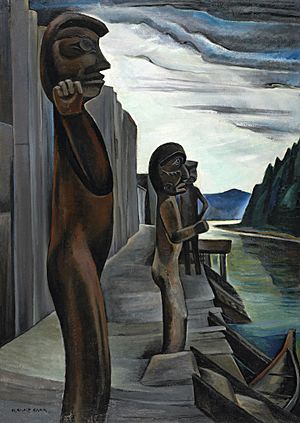Blunden Harbour facts for kids
Blunden Harbour is a small harbour and a special area for Indigenous people in the Canadian province of British Columbia. It is located on the mainland side of Queen Charlotte Strait, about 25 kilometres (15 miles) northeast of Port Hardy. Blunden Harbour was once the site of a village belonging to the Kwakwakaʼwakw people. The people who lived there called themselves the ʼNakʼwaxdaʼxw, also known as the Nakoaktok.
History of Blunden Harbour
This area was named Blunden Harbour in 1863. It was named by Daniel Pender, a Captain in the Royal Navy, after his Second Master, Edward Raynor Blunden. Other nearby places like Blunden Island and Blunden Rock are also named after him.
The 'Nak'waxda'xw people moved around the area. By 1884, they had set up a winter village at Blunden Harbour. The name for this place in their language, Kwakʼwala, is often written as Ba'as or Pahas. Today, the official name of the Indigenous reserve there is Pahas Indian Reserve 3.
In the early 1900s, some people tried to promote the area to European settlers. They called it Port Progress. However, this settlement did not last long. Port Progress is not an official name in Canada anymore.
In 1964, the community living at Blunden Harbour had to move. They were told to relocate to Port Hardy. The Canadian government department that worked with Indigenous communities said they would stop providing support for homes, schools, and other services if the people stayed in their isolated village. Before the community left by boat, their village was burned down. This was done to make sure they would not return to their old home.
Art and Film Connections

Blunden Harbour was home to many talented Kwakwakaʼwakw artists. One of the most famous was Willie Seaweed.
The name Blunden Harbour is also the title of a famous painting by Emily Carr. She created this painting between 1927 and 1932. It was based on a photograph taken in 1901 by Dr. Charles F. Newcombe. You can see this painting today at the National Gallery of Canada.
In 1951, a 22-minute film was made about Blunden Harbour by Robert Gardner. It was an anthropological film, meaning it studied human societies and cultures. In the film, Gardner incorrectly described Blunden Harbour as being on Vancouver Island.

